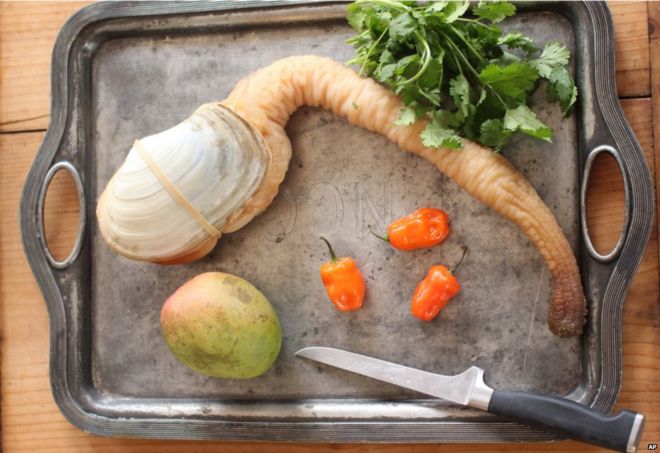It's not the most beautiful dinner to look at and it has a very odd name... but in China the geoduck is an expensive delicacy, so on North America's Pacific coast the race is on to farm them and cash in.
The first thing people notice is the shape - it's not nicknamed the King Clam for nothing.
Its long, probing siphon bulges out of its shell and burrows through the sand - sucking in sea water, and squirting it out again (minus vital nutrients) from its tip.
Even its name sounds peculiar when pronounced correctly: "gooey-duck".
It is the largest burrowing clam in the world and can weigh up to 16lb (7.25kg), but it has another claim to fame.
It tastes delicious.
So delicious in fact that diners at high-end seafood restaurants in China will pay up to $300 (£200) for a fresh geoduck imported live from Canada or the US.
Its delicate texture and exotic looks are prized by connoisseurs - who consider the "elephant trunk clam", as it is known in China, to be an aphrodisiac.
"You really feel a mouthful of the Pacific... it's slippery, it's very tender, very sweet," said diners interviewed by the BBC in Beijing.
Geoduck - the vital statistics
- The name "geoduck" is thought to come from the Nisqually (Native American) word "gweduc," meaning "dig deep"
- The bivalve grows in the tidal flats of Oregon, Washington State, British Columbia and Alaska, on beaches with deep sandy substrate
- It takes six years for a farmed geoduck to reach maturity but they can live up to 160 years- as measured by the rings on their shells
- The siphon can grow to 1m (3ft) or more in length
- The clams may be served sauteed, as chowder, sushi or sashimi, but are most often blanched in broth








0 komentar:
Posting Komentar